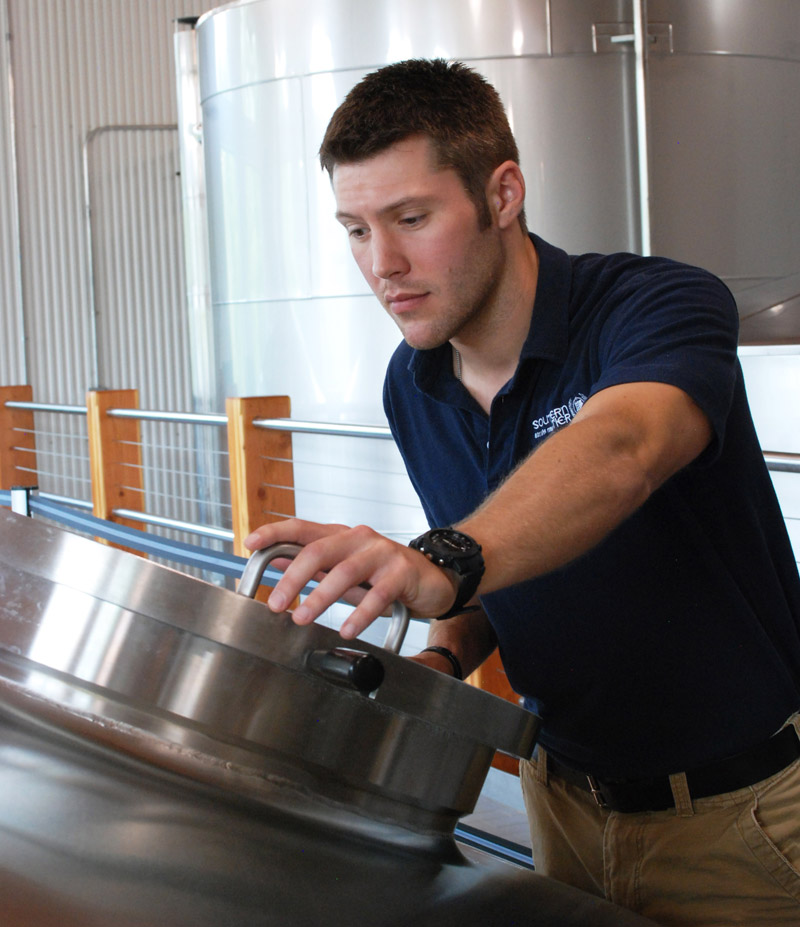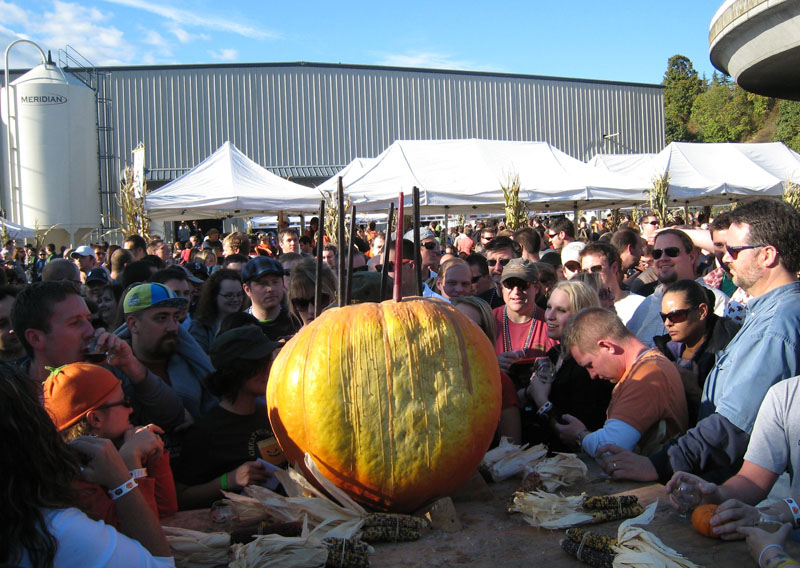Pumpkin Power: The Rise and Reign of Pumpkin Beer
Modern Pumpkin
In mid- to late July, when pumpkin beer starts to appear on the shelf, Cambridge Brewing Co. in Cambridge, MA, is brewing a Heather Ale, an herbal beer brewed with pounds of heather flower that the brewery staff and a group of volunteers hand-pick every July. Their Great Pumpkin Ale isn’t on their radar until late August, when they can find local Massachusetts sugar pumpkins, which means they can’t release their beer any earlier than the second or third week of September.
“So we’ll never be first to market, that’s for sure,” says CBC Brewmaster Will Meyers.
For Meyers, it’s an issue of quality and extracting the most flavor possible from the pumpkin.
“Pumpkins don’t have a lot of flavor—they’re a pretty mild squash—so by using them raw, according to our process, we’re extracting more starch which doesn’t get fermented out, and therefore we actually get a beer that has a fresh, squashy pumpkin flavor as opposed to a cooked pumpkin, puree character,” says Meyers.
Cinnamon and allspice are kept to a minimum—just enough to evoke a flavor memory response and trigger that familiar “pumpkin pie, Halloween, autumn reference in your memory,” says Meyers.
A pumpkin beer brewed with fresh pumpkin is a rarity. Brewers often express a desire to use it, but to meet volume and timing demands, puréed or frozen pumpkin is often preferred.
Southern Tier Brewing Co. uses 8,000 or more pounds of pumpkin purée annually for its nearly 20,000 barrels of Pumking, an 8.5% imperial pumpkin ale. Even sourcing that has become a challenge at times, says head brewer Dustin Hazer.
“We have to make sure that we have enough available so we can get through all of our orders. It was never something I thought I would be contracting out. Like hops, yup, barley, sure, pumpkins, yup, apparently so,” says Hazer.
According to the “Pumpkin King,” Elysian Brewing head brewer Dick Cantwell, a true pumpkin beer has to evoke the taste of the pumpkin itself.
“[Pumpkin beer] gives us a chance to show both how serious and how ridiculous we can be. You have to take the assignment seriously enough to actually use pumpkin,” says Cantwell, “and it’s not an effective pumpkin beer unless you can taste pumpkin in it. Throwing a little pumpkin in just for conceptual reasons isn’t enough. It really has to be a beer that takes into account what’s in it.”
The full range of pumpkin beers are on display at Elysian’s annual Great Pumpkin Beer Festival. Ten years running, the three-day festival features more than 80 different pumpkin beers, including more than 20 from Elysian—hence, Cantwell’s title as Pumpkin King.
His favorite new idea, he says, is a gin-inspired pumpkin beer for which he made tinctures of 10 gin botanicals like juniper and orange peel, added these tinctures to the beer and aged it in gin barrels. It’s called Gourdon’s, named for Gordon’s Gin, of course.
Cantwell has also taken on the role as a pumpkin beer mentor, consulting brewers interested in brewing with pumpkin and trying to entice his brewer friends to make a pumpkin beer for the festival.
“Every time I ask people who aren’t accustomed to doing them to do them, they always say, ‘Oh, I don’t know I don’t really want to.’ … They always say, ‘I don’t know if I can sell it.’ And I’m like, ‘Yes you can, of course you can sell it. You can sell just about any amount of pumpkin beer that you make.’”
The Seasonal Gripe
The selling power of pumpkin beer is, at first glance, undeniable.
Fred Forsley, co-founder of Shipyard Brewing Co. in Portland, ME, says that this year the company hopes to sell 60,000 barrels—more than one-third of total annual production—of Shipyard Pumpkinhead Ale, a 4.7% beer brewed with pumpkin flavor. Pumpkinhead’s runaway success has also allowed the company to grow in markets that it would otherwise not be in, Forsley says.
“We’ve gotten calls from distributors across the country saying, ‘Can I get Pumpkinhead?’ Even today, as competitive as things are, you have people wanting to bring that beer in,” says Forsley. The downfall of pumpkin’s popularity is that to meet the demand, the company has to start brewing Pumpkinhead in July and shipping and releasing it in late July and August.
Weyerbacher Brewing Co.’s Imperial Pumpkin Ale sales top its AutumnFest beer, an Oktoberfest, nearly seven to one, according to head brewer Chris Wilson. So Weyerbacher starts brewing Imperial Pumpkin in May, releases it at the brewery on July 17 and into the market shortly after, while AutumnFest is released on Sept. 1.
With more than 3,000 breweries operating in the country, there is also more seasonal beer available and the pressure to be “first to the market” mounts, says beer industry consultant Bump Williams.
“It’s traditionally a race to see who’s going to get on display. People can fight and clamor for points of distribution all they want, what really sells the beer is getting on the floor. Displays are critical for selling beer,” says Williams. “I also think it’s a problem with forecasting. There’s no clean cut-off day that says on September 1 we’re going to stop selling summer beers and we’re going to start selling fall beers.”
For retailers, it ends up being a balancing act.
“Seasonal beer can be an issue because we still have a lot of summer beer on the shelves and all of a sudden we have pumpkin beers starting to show up. And once people start seeing fall beers, they don’t want to buy summer beers anymore,” says Ted Kenny, owner of Top Hops Beer Shop in New York City.
During last year’s pumpkin season, Kenny sold out his first shipment of pumpkin beer by September and when he went to reorder, his distributors were out of stock and he had to wait for his orders to be filled.
Some beer stores are fighting back. Last year, Craft Beer Cellar, which had locations in Belmont and Winchester, MA, at the time, announced it wouldn’t sell any pumpkin beer until Sept. 1. However, it still had to purchase pumpkin beer for the fall, so the stores ended up with nearly 800 cases, about $30,000 worth of beer, in their basements before they started bringing it up for Sept. 1. The customers, co-owner Suzanne Schalow says, supported their decision, but it became a logistically challenging and expensive issue.
“We really just want to enjoy our summer,” says Schalow. “We were trying to buy summer beer in August, and we were being told there wasn’t any more, or there wouldn’t be any more available because pumpkin beer was coming in.”
Pumpkin Power Holds Strong
As other trends come and go in brewing, the pumpkin beer, and pumpkin flavoring, seems to hold strong.
“Right now, we’re looking at a phenomenal growth rate of pumpkin beers,” says Williams.
Seasonal beers are the second most popular category of beer styles, according to industry analysts IRI, second only to the IPA. And within seasonals, fall is the best-selling season and pumpkin beer the star seasonal.
Yet the real hero of this story may be the pumpkin itself: a simple squash that has managed to propel itself from a bland-tasting crop into a beloved American icon. Even more incredibly, the power of its myth has managed to make the stories a reality.
“These romantic ideas we have about ourselves, about pumpkins through the pumpkin, aren’t just stories from story books or paintings in galleries, but these myths and these stories and these paintings actually change how markets operate,” says Cindy Ott. [Pumpkin beer] is also fueling that fascination and appreciation that is sending people out still to buy the pumpkin.”
And we’re all too happy to buy into it, too, every year from September (or July, rather) to November, when the power of the pumpkin takes hold.
Heather Vandenengel
Heather Vandenengel is a freelance beer journalist and news editor for All About Beer Magazine. She is based in Montreal, QC, but takes any excuse to travel, especially when it’s for beer.





Pumpkin beers come out in July now. A bit too early.
Beer producers are diluting the impact and tradition of seasonal beers by releasing them far too early into the retail market. By giving customers everything they desire the product becomes less desirable and eventually the demand will dwindle. Octoberfest and Pumpkin in July. Christmas in October. Spring in January and Summer in March. I am retailer and already have seen this downward trend happen to some seasonals.
@jb. I agree that Pumpkin beers in July is overkill. But unfortunately this is no different than any other industry, pushing their wares a season early (shorts in march anyone?).
@Michael Papacek. No disagreement there. Unfortunately large warehouse stores (e.g. BevMo, Costco, Total Wine, etc.) demand shelves with seasonals. So the only choice a brewery has is to commit when a pallet or more is on the line.
-My 2 cents.
This is not beer. Its crap. Cool ade. It’s a decline in the tradition of beer and ale. Even the multitude of India pale ales is crazy. How many hops can you add? Buds idea of beer o Rita ‘ s is another ridiculous trend. Call them something other than beer.
@Mike – I disagree the pumpkin beer is total crap, but that’s a matter of opinion and not “fact”. Your stance on IPA’s I actually agree with, but, alas, it is also an opinion. Cheers.
I read that there was no pumpkin in that first beer… Anyway it’s pumpkin pie beer, not pumpkin ale. Oh and most ‘pumpkin’ beers were probably brewed with what we would call winter squash. Even now pumpkin is a not-very-specific term – usually means a round squash! Most canned pumpkin is a winter squash that we would not now call a pumpkin. And saying it has no flavor is rediculous. I add roasted squash to beer and there is a very definite flavor, though perhaps not what most people would call pumpkin flavor (again that’s pumpkin pie), but there are roasted caramel notes, earthy, and it adds some sourness (not expected, but it does so each time).